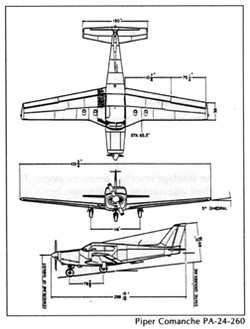...Airplane Impacted Power Lines. The Power Lines Were About 95 Ft Above Ground Level
Location: Oklahoma City, OK Accident Number: CEN23FA360
Date & Time: August 13, 2023, 12:50 Local Registration: N7910P
Aircraft: Piper PA-24-250 Injuries: 1 Serious
Flight Conducted Under: Part 91: General aviation - Personal

On August 13, 2023, at about 1250 central daylight time, a Piper PA-24-250, N7910P, was substantially damaged when it was involved in an accident near Oklahoma City, Oklahoma. The pilot was seriously injured. The airplane was operated as a Title 14 Code of Federal Regulations Part 91 personal flight.
Automatic Dependent Surveillance – Broadcast (ADS-B) data revealed that the airplane departed North Texas Regional/Perrin Field (GYI) Sherman, Texas, at 1204 and proceeded to Wiley Post Airport (PWA) Oklahoma City, Oklahoma. Shortly after being transferred from Oklahoma City Approach to Wiley Post Tower, the pilot told tower controllers that he was losing rpm, and he was going to make an emergency landing on Interstate 35.
According to a witness traveling northbound on Interstate 235, the airplane impacted power lines. The power lines were about 95 ft above ground level, and the airplane was on a heading of about 348° before it impacted a sloped grassy area on the east side of Interstate 235 just south of Interstate 44. The airplane traveled about 40 ft from the impact site to the main wreckage area and came to rest upright on a heading of about 150°.
The propeller was impact separated at the flange and two distinct propeller gouge marks were found on the ground about 18 in apart. The propeller came to rest vertically about 15 ft east of the main wreckage with one blade embedded about 8 inches in the ground.

The right-wing tip and about two ft of the outboard right wing were found under the power lines. The remainder of the right wing, with flap attached, remained attached to the fuselage and were bent and wrinkled. The right aileron was impact separated and found about 12 ft west of the main wreckage. The left wing exhibited crush damage along the leading edge, and the left-wing tip was impact separated andfound along thedebris path. The left-wing tore away from the fuselage and separated into two pieces; however, the pieces were still attached to each other and to the fuselage by the aileron cables. The left flap was still attached to the left wing. Both left and rights flaps appeared to be extended about 9°. The ailerons could not be functionally tested due to the impact separation; however, the aileron cables were traced back to the yoke.
The vertical stabilizer, rudder, horizontal stabilizer, and elevator were still attached to the fuselage. All engine accessories remained attached to the engine. The engine was attached to the engine mount, and the engine mount was attached to the firewall. The landing gear was in the retracted position and remained attached to the fuselage. The debris field, about 40 ft long and 20 ft wide, was situated on an east to west heading, and contained the left-wing tip and shattered wind screen. The grass along the debris path exhibited a considerable amount of fuel blight.
The cockpit was impact damaged especially on the left side; however, all avionics and gauges were still attached to the panel. The throttle, mixture, carburetor heat, and propeller control were found in the full forward positions. The altimeter setting in the Kollsman window was set to 30.08.
The main fuel cell and auxiliary fuel cell on the left wing were crushed due to impact damage and could not be functionally tested. The right main fuel cell did not have any fuel in it, and the right auxiliary fuel cell was full of fuel. The fuel selector valve was set to the right main cell. The fuel boost pump switch in the cockpit appeared to be in the “on” position. Electrical power was applied to the electric fuel boost pumps, and they were audibly operating.
The airplane wreckage was retained for further examination.
 ANN's Daily Aero-Term (10.13.25): Homing [ICAO]
ANN's Daily Aero-Term (10.13.25): Homing [ICAO] ANN's Daily Aero-Linx (10.13.25)
ANN's Daily Aero-Linx (10.13.25) ANN FAQ: Q&A 101
ANN FAQ: Q&A 101 NTSB Prelim: CubCrafters Carbon Cub
NTSB Prelim: CubCrafters Carbon Cub ANN's Daily Aero-Term (10.14.25): Severe Icing
ANN's Daily Aero-Term (10.14.25): Severe Icing




